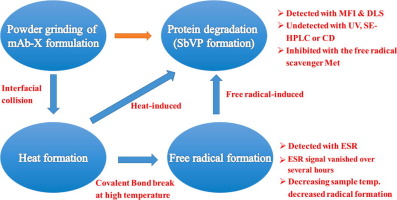当前位置:
X-MOL 学术
›
Eur. J. Pharm. Biopharm.
›
论文详情
Our official English website, www.x-mol.net, welcomes your feedback! (Note: you will need to create a separate account there.)
Formation of Protein Sub-Visible Particles during Powder Grinding of a Monoclonal Antibody.
European Journal of Pharmaceutics and Biopharmaceutics ( IF 4.9 ) Pub Date : 2020-01-29 , DOI: 10.1016/j.ejpb.2020.01.014 Ci Qian 1 , Guanqi Wang 2 , Xinyu Wang 3 , James Barnard 4 , Jian-Qing Gao 5 , Wenhan Bao 6 , Haibin Wang 7 , Fengzhu Li 7 , Rahul Gajanan Ingle 2 , Wei-Jie Fang 2
European Journal of Pharmaceutics and Biopharmaceutics ( IF 4.9 ) Pub Date : 2020-01-29 , DOI: 10.1016/j.ejpb.2020.01.014 Ci Qian 1 , Guanqi Wang 2 , Xinyu Wang 3 , James Barnard 4 , Jian-Qing Gao 5 , Wenhan Bao 6 , Haibin Wang 7 , Fengzhu Li 7 , Rahul Gajanan Ingle 2 , Wei-Jie Fang 2
Affiliation

|
We have observed an interesting phenomenon in which grinding of freeze-dried monoclonal antibody X (mAb-X) formulation powder resulted to significant protein sub-visible particles (SbVPs) in the reconstituted liquid, which could only be observed by sensitive particle analytical methods such as MFI and DLS. Effects of grinding temperature and the free radical scavengers methionine and 3-carbamoyl-2,2,5,5-tetramethyl-1-pyrrolidin-yloxy free radical (CTPO) on the formation of SbVPs were also evaluated. Free radicals were observed by EPR and the amount of free radicals was correlated to the sample temperature prior to grinding. Formation of SbVPs could be partially inhibited by methionine and CTPO. The amount of SbVPs formed was dependent on the amount of free radicals / sample temperature prior to grinding. At higher temperatures, more free radicals and SbVPs formed. Other than the previously known protein degradation due to high temperature formed during mechanical grinding, we propose an unreported and supplementary mechanism, i.e., the formation of free radicals (i.e., due to break of C-O or C-S bonds) in the dried state during mechanical grinding, leading to protein particle formation in the reconstituted solution. Our observation suggested that mechanical grinding of protein powder should be avoided or used cautiously (i.e., grinding temperature, strength and time) and the effects on radical and particle formation be fully evaluated.
中文翻译:

单克隆抗体的粉末研磨过程中蛋白质亚可见颗粒的形成。
我们已经观察到一个有趣的现象,其中冷冻干燥的单克隆抗体X(mAb-X)制剂粉末的研磨会在重构液中产生明显的蛋白质亚可见颗粒(SbVPs),这只能通过敏感的颗粒分析方法来观察,例如作为MFI和DLS。还评估了研磨温度和自由基清除剂蛋氨酸和3-氨基甲酰基-2,2,5,5-四甲基-1-吡咯烷丁酰氧基自由基(CTPO)对SbVPs形成的影响。通过EPR观察到自由基,并且在研磨之前,自由基的量与样品温度相关。蛋氨酸和CTPO可部分抑制SbVPs的形成。形成的SbVP的数量取决于研磨前自由基/样品温度的数量。在更高的温度下 形成更多的自由基和SbVP。除了先前已知的由于机械研磨过程中形成的高温而导致蛋白质降解之外,我们提出了一种未报道的补充机制,即在机械研磨过程中处于干燥状态时自由基的形成(即,由于CO或CS键的断裂)导致重组溶液中蛋白质颗粒的形成。我们的观察结果表明,应避免或谨慎使用蛋白质粉的机械研磨(即研磨温度,强度和时间),并且应充分评估其对自由基和颗粒形成的影响。由于在机械研磨过程中处于干燥状态而导致CO或CS键断裂),导致在重组溶液中形成蛋白质颗粒。我们的观察结果表明,应避免或谨慎使用蛋白质粉的机械研磨(即研磨温度,强度和时间),并且应充分评估其对自由基和颗粒形成的影响。由于在机械研磨过程中处于干燥状态而导致CO或CS键断裂),导致在重组溶液中形成蛋白质颗粒。我们的观察结果表明,应避免或谨慎使用蛋白质粉的机械研磨(即研磨温度,强度和时间),并充分评估其对自由基和颗粒形成的影响。
更新日期:2020-01-31
中文翻译:

单克隆抗体的粉末研磨过程中蛋白质亚可见颗粒的形成。
我们已经观察到一个有趣的现象,其中冷冻干燥的单克隆抗体X(mAb-X)制剂粉末的研磨会在重构液中产生明显的蛋白质亚可见颗粒(SbVPs),这只能通过敏感的颗粒分析方法来观察,例如作为MFI和DLS。还评估了研磨温度和自由基清除剂蛋氨酸和3-氨基甲酰基-2,2,5,5-四甲基-1-吡咯烷丁酰氧基自由基(CTPO)对SbVPs形成的影响。通过EPR观察到自由基,并且在研磨之前,自由基的量与样品温度相关。蛋氨酸和CTPO可部分抑制SbVPs的形成。形成的SbVP的数量取决于研磨前自由基/样品温度的数量。在更高的温度下 形成更多的自由基和SbVP。除了先前已知的由于机械研磨过程中形成的高温而导致蛋白质降解之外,我们提出了一种未报道的补充机制,即在机械研磨过程中处于干燥状态时自由基的形成(即,由于CO或CS键的断裂)导致重组溶液中蛋白质颗粒的形成。我们的观察结果表明,应避免或谨慎使用蛋白质粉的机械研磨(即研磨温度,强度和时间),并且应充分评估其对自由基和颗粒形成的影响。由于在机械研磨过程中处于干燥状态而导致CO或CS键断裂),导致在重组溶液中形成蛋白质颗粒。我们的观察结果表明,应避免或谨慎使用蛋白质粉的机械研磨(即研磨温度,强度和时间),并且应充分评估其对自由基和颗粒形成的影响。由于在机械研磨过程中处于干燥状态而导致CO或CS键断裂),导致在重组溶液中形成蛋白质颗粒。我们的观察结果表明,应避免或谨慎使用蛋白质粉的机械研磨(即研磨温度,强度和时间),并充分评估其对自由基和颗粒形成的影响。



























 京公网安备 11010802027423号
京公网安备 11010802027423号